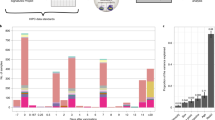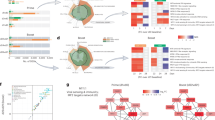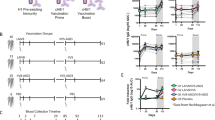Abstract
Systems vaccinology has defined molecular signatures and mechanisms of immunity to vaccination. However, comparative analysis of immunity to different vaccines is lacking. We integrated transcriptional data of over 3,000 samples, from 820 adults across 28 studies of 13 vaccines and analyzed vaccination-induced signatures of antibody responses. Most vaccines induced signatures of innate immunity and plasmablasts at days 1 and 7, respectively, after vaccination. However, the yellow fever vaccine induced an early transient signature of T and B cell activation at day 1, followed by delayed antiviral/interferon and plasmablast signatures that peaked at days 7 and 14–21, respectively. Thus, there was no evidence for a ‘universal signature’ that predicted antibody response to all vaccines. However, accounting for the asynchronous nature of responses, we defined a time-adjusted signature that predicted antibody responses across vaccines. These results provide a transcriptional atlas of immunity to vaccination and define a common, time-adjusted signature of antibody responses.
This is a preview of subscription content, access via your institution
Access options
Access Nature and 54 other Nature Portfolio journals
Get Nature+, our best-value online-access subscription
$32.99 / 30 days
cancel any time
Subscribe to this journal
Receive 12 print issues and online access
$259.00 per year
only $21.58 per issue
Buy this article
- Purchase on SpringerLink
- Instant access to full article PDF
Prices may be subject to local taxes which are calculated during checkout






Similar content being viewed by others

Data availability
All data used in this study are available from ImmuneSpace (https://www.immunespace.org/is2.url).
Code availability
R code used to generate the figures is available from ImmuneSpace.
References
Hagan, T., Nakaya, H. I., Subramaniam, S. & Pulendran, B. Systems vaccinology: enabling rational vaccine design with systems biological approaches. Vaccine 33, 5294–5301 (2015).
Pulendran, B. Systems vaccinology: probing humanity’s diverse immune systems with vaccines. Proc. Natl Acad. Sci. USA 111, 12300–12306 (2014).
Querec, T. D. et al. Systems biology approach predicts immunogenicity of the yellow fever vaccine in humans. Nat. Immunol. 10, 116–125 (2009).
Gaucher, D. et al. Yellow fever vaccine induces integrated multilineage and polyfunctional immune responses. J. Exp. Med. 205, 3119–3131 (2008).
Nakaya, H. I. et al. Systems biology of vaccination for seasonal influenza in humans. Nat. Immunol. 12, 786–795 (2011).
Bucasas, K. L. et al. Early patterns of gene expression correlate with the humoral immune response to influenza vaccination in humans. J. Infect. Dis. 203, 921–929 (2011).
Zak, D. E. et al. Merck Ad5/HIV induces broad innate immune activation that predicts CD8+ T cell responses but is attenuated by preexisting Ad5 immunity. Proc. Natl Acad. Sci. USA 109, E3503–E3512 (2012).
Obermoser, G. et al. Systems scale interactive exploration reveals quantitative and qualitative differences in response to influenza and pneumococcal vaccines. Immunity 38, 831–844 (2013).
Banchereau, R. et al. Transcriptional specialization of human dendritic cell subsets in response to microbial vaccines. Nat. Commun. 5, 5283 (2014).
Li, S. et al. Molecular signatures of antibody responses derived from a systems biology study of five human vaccines. Nat Immunol. 15, 195–204 (2014).
Tsang, J. S. et al. Global analyses of human immune variation reveal baseline predictors of postvaccination responses. Cell 157, 499–513 (2014).
Fourati, S. et al. Pre-vaccination inflammation and B cell signalling predict age-related hyporesponse to hepatitis B vaccination. Nat. Commun. 7, 10369 (2016).
Li, S. et al. Metabolic phenotypes of response to vaccination in humans. Cell 169, 862–877 (2017).
Kazmin, D. et al. Systems analysis of protective immune responses to RTS,S malaria vaccination in humans. Proc. Natl Acad. Sci. USA 114, 2425–2430 (2017).
Rechtien, A. et al. Systems vaccinology identifies an early innate immune signature as a correlate of antibody responses to the Ebola vaccine rVSV-ZEBOV. Cell Rep. 20, 2251–2261 (2017).
Kotliarov, Y. et al. Broad immune activation underlies shared set point signatures for vaccine responsiveness in healthy individuals and disease activity in patients with lupus. Nat. Med. 26, 618–629 (2020).
Arunachalam, P. S. et al. Systems vaccinology of the BNT162b2 mRNA vaccine in humans. Nature 596, 410–416 (2021).
Nakaya, H. I. et al. Systems analysis of immunity to influenza vaccination across multiple years and in diverse populations reveals shared molecular signatures. Immunity 43, 1186–1198 (2015).
Thakar, J. et al. Aging-dependent alterations in gene expression and a mitochondrial signature of responsiveness to human influenza vaccination. Aging 7, 38–52 (2015).
Avey, S. et al. Seasonal variability and shared molecular signatures of inactivated influenza vaccination in young and older adults. J. Immunol. 204, 1661–1673 (2020).
Ravindran, R. et al. Vaccine activation of the nutrient sensor GCN2 in dendritic cells enhances antigen presentation. Science 343, 313–317 (2014).
Hagan, T. et al. Antibiotics-driven gut microbiome perturbation alters immunity to vaccines in humans. Cell 178, 1313–1328 (2019).
Oh, J. Z. et al. TLR5-mediated sensing of gut microbiota is necessary for antibody responses to seasonal influenza vaccination. Immunity 41, 478–492 (2014).
Pulendran, B. Learning immunology from the yellow fever vaccine: innate immunity to systems vaccinology. Nat. Rev. Immunol. 9, 741–747 (2009).
Pulendran, B., Li, S. & Nakaya, H. I. Systems vaccinology. Immunity 33, 516–529 (2010).
Diray-Arce, J. et al. The Immune Signatures Data Resource: a compendium of systems vaccinology datasets. Preprint at bioRxiv https://doi.org/10.1101/2021.11.05.465336 (2021).
Bhattacharya, S. et al. ImmPort, toward repurposing of open access immunological assay data for translational and clinical research. Sci. Data. 5, 180015 (2018).
Scherer A. Batch Effects and Noise in Microarray Experiments: Sources and Solutions (John Wiley and Sons, 2009).
Gasparini, R. & Panatto, D. Meningococcal glycoconjugate vaccines. Hum. Vaccin. 7, 170–182 (2011).
Granoff, D. M., Rathore, M. H., Holmes, S. J., Granoff, P. D. & Lucas, A. H. Effect of immunity to the carrier protein on antibody responses to Haemophilus influenzae type b conjugate vaccines. Vaccine 11, S46–S51 (1993).
Aran, D., Hu, Z. & Butte, A. J. xCell: digitally portraying the tissue cellular heterogeneity landscape. Genome Biol. 18, 220 (2017).
Plotkin, S. A. Correlates of protection induced by vaccination. Clin. Vaccine Immunol. 17, 1055–1065 (2010).
Furman, D. et al. Apoptosis and other immune biomarkers predict influenza vaccine responsiveness. Mol. Syst. Biol. 9, 659 (2013).
Sobolev, O. et al. Adjuvanted influenza-H1N1 vaccination reveals lymphoid signatures of age-dependent early responses and of clinical adverse events. Nat. Immunol. 17, 204–213 (2016).
Moro-Garcia, M. A., Alonso-Arias, R. & Lopez-Larrea, C. When aging reaches CD4+ T cells: phenotypic and functional changes. Front Immunol. 4, 107 (2013).
Frasca, D. & Blomberg, B. B. Effects of aging on B cell function. Curr. Opin. Immunol. 21, 425–430 (2009).
Panda, A. et al. Age-associated decrease in TLR function in primary human dendritic cells predicts influenza vaccine response. J. Immunol. 184, 2518–2527 (2010).
Kollmann, T. R., Levy, O., Montgomery, R. R. & Goriely, S. Innate immune function by Toll-like receptors: distinct responses in newborns and the elderly. Immunity 37, 771–783 (2012).
Querec, T. et al. Yellow fever vaccine YF-17D activates multiple dendritic cell subsets via TLR2, 7, 8 and 9 to stimulate polyvalent immunity. J. Exp. Med. 203, 413–424 (2006).
Kasturi, S. P. et al. Programming the magnitude and persistence of antibody responses with innate immunity. Nature 470, 543–547 (2011).
Thurmond, S., Wang, B., Song, J. & Hai, R. Suppression of type I interferon signaling by flavivirus NS5. Viruses 10, 712 (2018).
Smith, G. L. et al. Vaccinia virus immune evasion: mechanisms, virulence and immunogenicity. J. Gen. Virol. 94, 2367–2392 (2013).
Bulteau, R. & Francesconi, M. Real age prediction from the transcriptome with RAPToR. Nat. Methods 19, 969–975 (2022).
Irizarry, R. A. et al. Exploration, normalization, and summaries of high density oligonucleotide array probe level data. Biostatistics 4, 249–264 (2003).
Law, C. W., Chen, Y., Shi, W. & Smyth, G. K. voom: Precision weights unlock linear model analysis tools for RNA-seq read counts. Genome Biol. 15, R29 (2014).
Dewey, M. metap: meta-analysis of significance values. R package version 1.8 http://www.dewey.myzen.co.uk/meta/meta.html (2022).
Yaari, G., Bolen, C. R., Thakar, J. & Kleinstein, S. H. Quantitative set analysis for gene expression: a method to quantify gene set differential expression including gene–gene correlations. Nucleic Acids Res. 41, e170 (2013).
Acknowledgements
This research was performed as a project of the HIPC and supported by the National Institute of Allergy and Infectious Diseases (NIAID). This work was supported in part by NIH grants U19AI118608, U19AI128949, U19AI090023, U19AI118626, U19AI089992, U19AI128914, U19AI128910, U19AI118610 and U19AI128913 and the Intramural Program of NIAID and NIH supporting the Trans-NIH Center for Human Immunology. O.L. is supported in part by the Department of Pediatrics at Boston Children’s Hospital. Work in the laboratory of B.P. is supported in part by the NIH (R37 DK057665, R01 AI048638, U19 AI057266 and U19 AI167903), Bill and Melinda Gates Foundation, Open Philanthropy and the Violetta L. Horton and Soffer Endowments to B.P.
Author information
Authors and Affiliations
Consortia
Contributions
Conception or design of the work: B.P. and S.H.K. Analysis: T.H., B.G., L.E.T. and A.L. Acquisition: E.H., H.E.R.M., J.D.-A., P.D., the HIPC, O.L., R.G., M.M.S., J.S.T., M.S.-F., S.F., M.P.M., D.G.C. and D.R. Interpretation of the data and manuscript writing: T.H., B.P., S.H.K. and R.-P.S.
Corresponding authors
Ethics declarations
Competing interests
O.L. is a named inventor on patents held by Boston Children’s Hospital regarding human in vitro systems modeling vaccine action and vaccine adjuvants. B.P. serves on the External Immunology Network of GSK, and on the scientific advisory board of Medicago, CircBio, Sanofi, EdJen and Boehringer-Ingelheim. S.H.K. receives consulting fees from Northrop Grumman and Peraton. T.H. owns stock in GSK and Pfizer. The remaining authors declare no competing interests.
Peer review
Peer review information
Nature Immunology thanks Galit Alter and the other, anonymous, reviewer(s) for their contribution to the peer review of this work. Primary Handling Editor: Jamie D. K. Wilson, in collaboration with the Nature Immunology team.
Additional information
Publisher’s note Springer Nature remains neutral with regard to jurisdictional claims in published maps and institutional affiliations.
Extended data
Extended Data Fig. 1 Overlap in differentially expressed genes/modules and kinetics of common module clusters.
a, b) Histograms of overlap in DEGs (A) or differentially expressed modules (B) between vaccines. A gene/module is shared with another vaccine if it is significantly (FDR < 0.05) regulated in the same direction, irrespective of timepoint. Blue bars, number of genesets shared (y-axis) between the same number of vaccines (x-axis). Grey bars represent the null distribution generated by n = 10,000 permutations of gene/module labels within vaccine + timepoint groups. Data are presented as mean values + /− 95% confidence interval. c) Kinetics of the mean FC of cluster 2 BTMs across vaccines. d) Kinetics of the mean FC of cluster 4 modules across vaccines.
Extended Data Fig. 2 Gene-level correlations between vaccines and estimated cell frequencies.
a) Correlation matrix of pairwise Spearman correlations of Day 3 gene-level fold changes between vaccines. b) Correlation matrix of pairwise Spearman correlations of Day 7 gene-level fold changes between vaccines. c) Scatterplot of Day 1 gene FCs between HIV and Malaria vaccines. d) Scatterplot of Day 1 gene FCs between Yellow Fever and Pneumococcus vaccines. e) Boxplot of Day 1 FC in xCell31 estimated B cell frequencies across vaccines. Center line, median; box limits, upper and lower quartiles; whiskers, 1.5x interquartile range. Ebola (RVV): n = 11, HIV (RVV): n = 10, Influenza (IN): n = 298, Malaria (RP): n = 42, Pneumococcus (PS): n = 12, Varicella Zoster (LA): n = 31, Yellow Fever (LA): n = 11. f-g) Kinetics of the mean FC of modules (F) M47.0 and (G) M75 across YF vaccine studies. In C-D, correlation coefficient and p value determined via Pearson correlation. In E, statistical differences were determined via two-sided paired Student’s t-tests within each study and integrating p values across studies within each vaccine using Stouffer’s method (see Methods for further details). *p < 0.05, **p < 0.01, ***p < 0.001, **** p < 0.0001.
Extended Data Fig. 3 Impact of pre-existing antibody levels on transcriptional responses to influenza vaccination.
a) Differentially expressed modules at Day 1 (FDR < 0.05, t-test between mean fold changes) between participants with high and low baseline antibody titers (negative score indicates increased expression in the low baseline antibody group). Differentially expressed modules at Day 7 between high and low baseline antibody groups. c, d) Boxplots of (C) IFN signature module M75 expression at Day 1 and (D) plasma cell module M156.1 expression at Day 7 between high and low baseline antibody groups at Day 1. Center line, median; box limits, upper and lower quartiles; whiskers, 1.5x interquartile range. Day 1: SDY1276_D: High – n = 35, Low – n = 31; SDY1276_V: High – n = 31, Low – n = 31; SDY180: High – n = 4, Low – n = 4; SDY56: High – n = 4, Low – n = 7; SDY80: High – n = 14, Low – n = 14. Day 7: SDY1119: High – n = 6, Low – n = 6; SDY180: High – n = 4, Low – n = 4; SDY270: High – n = 10, Low – n = 9; SDY56: High – n = 4, Low – n = 7; SDY61: High – n = 3, Low – n = 3; SDY63: High – n = 3, Low – n = 4; SDY640: High – n = 6, Low – n = 4; SDY80: High – n = 13, Low – n = 13. e, f) Line graphs of (E) M75 and (F) M156.1 expression across time in high and low baseline antibody groups. Error bars represent standard error of the mean. Day 1: High – n = 88, Low – n = 87; Day 3: High – n = 83, Low – n = 88; Day 7: High – n = 49, Low – n = 50; Day 14: High – n = 64, Low – n = 66; In C-F, statistical differences were determined via two-sided unpaired Student’s t-tests. *p < 0.05, **p < 0.01, ***p < 0.001.
Extended Data Fig. 4 Antibody response prediction across vaccines.
a) Boxplots of Day 30 antibody responses to vaccination across vaccines. Center line, median; box limits, upper and lower quartiles; whiskers, 1.5x interquartile range. Hepatitis A/B (IN/RP): n = 25, Influenza (IN): n = 412, Influenza (LA): n = 28, Meningococcus (CJ): n = 17, Meningococcus (PS): n = 13, Pneumococcus (PS): n = 6, Smallpox (LA): n = 8, Tuberculosis (RVV): n = 12, Varicella Zoster (LA): n = 16, Yellow Fever (LA): n = 35. b) Barplot of feature importance for the GLM classifier trained on inactivated influenza datasets only. c) AUC barplot of antibody response prediction performance across vaccines for the GLM classifier trained on inactivated influenza datasets only. Data are presented as mean values + /- 95% confidence interval. n = 2000 bootstrap replicates. d) AUC barplot of antibody response prediction performance of the leave-one-vaccine-out GLM classifier. Data are presented as mean values + /- 95% confidence interval. n = 2000 bootstrap replicates. e) AUC barplot of antibody response prediction performance of the 10-fold cross-validation GLM classifier. Data are presented as mean values + /- 95% confidence interval. n = 2000 bootstrap replicates.
Extended Data Fig. 5 Comparison of common transcriptional responses between age groups.
a) Scatterplots of module activity scores in each vaccine among young (x-axis) and older participants (y-axis) of the most commonly expressed modules (Fig. 2a) on days 1–7. Correlation coefficient and p value determined via Pearson correlation.
Supplementary information
Supplementary Information
Supplementary Table 1
Rights and permissions
Springer Nature or its licensor holds exclusive rights to this article under a publishing agreement with the author(s) or other rightsholder(s); author self-archiving of the accepted manuscript version of this article is solely governed by the terms of such publishing agreement and applicable law.
About this article
Cite this article
Hagan, T., Gerritsen, B., Tomalin, L.E. et al. Transcriptional atlas of the human immune response to 13 vaccines reveals a common predictor of vaccine-induced antibody responses. Nat Immunol 23, 1788–1798 (2022). https://doi.org/10.1038/s41590-022-01328-6
Received:
Accepted:
Published:
Issue date:
DOI: https://doi.org/10.1038/s41590-022-01328-6
This article is cited by
-
Reference-guided detection of the transcriptome reveals circular RNA-related competing endogenous RNA networks in response to three respiration pathogens in pig lungs
Virology Journal (2025)
-
Understanding and improving vaccine efficacy in older adults
Nature Aging (2025)
-
Biochemical and hematological reference intervals in rhesus and cynomolgus macaques and implications for vaccine and drug development
Lab Animal (2025)
-
Systems vaccinology identifies immunological correlates of SARS-CoV-2 vaccine response in solid organ transplant recipients
npj Vaccines (2025)
-
Bifidobacteria support optimal infant vaccine responses
Nature (2025)


